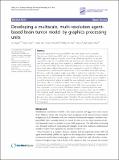| dc.contributor.author | Zhang, Le | |
| dc.contributor.author | Jiang, Beini | |
| dc.contributor.author | Wu, Yukun | |
| dc.contributor.author | Strouthos, Costas | |
| dc.contributor.author | Su, Jing | |
| dc.contributor.author | Zhou, Xiaobo | |
| dc.contributor.author | Sun, Phillip Zhe | |
| dc.date.accessioned | 2012-05-07T19:01:19Z | |
| dc.date.available | 2012-05-07T19:01:19Z | |
| dc.date.issued | 2011-12 | |
| dc.date.submitted | 2011-11 | |
| dc.identifier.issn | 1742-4682 | |
| dc.identifier.uri | http://hdl.handle.net/1721.1/70525 | |
| dc.description.abstract | Abstract Multiscale agent-based modeling (MABM) has been widely used to simulate Glioblastoma Multiforme (GBM) and its progression. At the intracellular level, the MABM approach employs a system of ordinary differential equations to describe quantitatively specific intracellular molecular pathways that determine phenotypic switches among cells (e.g. from migration to proliferation and vice versa). At the intercellular level, MABM describes cell-cell interactions by a discrete module. At the tissue level, partial differential equations are employed to model the diffusion of chemoattractants, which are the input factors of the intracellular molecular pathway. Moreover, multiscale analysis makes it possible to explore the molecules that play important roles in determining the cellular phenotypic switches that in turn drive the whole GBM expansion. However, owing to limited computational resources, MABM is currently a theoretical biological model that uses relatively coarse grids to simulate a few cancer cells in a small slice of brain cancer tissue. In order to improve this theoretical model to simulate and predict actual GBM cancer progression in real time, a graphics processing unit (GPU)-based parallel computing algorithm was developed and combined with the multi-resolution design to speed up the MABM. The simulated results demonstrated that the GPU-based, multi-resolution and multiscale approach can accelerate the previous MABM around 30-fold with relatively fine grids in a large extracellular matrix. Therefore, the new model has great potential for simulating and predicting real-time GBM progression, if real experimental data are incorporated. | en_US |
| dc.publisher | BioMed Central Ltd | en_US |
| dc.relation.isversionof | http://dx.doi.org/10.1186/1742-4682-8-46 | en_US |
| dc.rights | Creative Commons Attribution | en_US |
| dc.rights.uri | http://creativecommons.org/licenses/by/2.0 | en_US |
| dc.source | BioMed Central Ltd | en_US |
| dc.title | Developing a multiscale, multi-resolution agent-based brain tumor model by graphics processing units | en_US |
| dc.type | Article | en_US |
| dc.identifier.citation | Theoretical Biology and Medical Modelling. 2011 Dec 16;8(1):46 | en_US |
| dc.contributor.department | Harvard University--MIT Division of Health Sciences and Technology | en_US |
| dc.contributor.mitauthor | Sun, Phillip Zhe | |
| dc.relation.journal | Theoretical Biology and Medical Modelling | en_US |
| dc.eprint.version | Final published version | en_US |
| dc.identifier.pmid | 22176732 | |
| dc.type.uri | http://purl.org/eprint/type/JournalArticle | en_US |
| eprint.status | http://purl.org/eprint/status/PeerReviewed | en_US |
| dc.date.updated | 2012-03-26T15:06:21Z | |
| dc.language.rfc3066 | en | |
| dc.rights.holder | Zhang et al.; licensee BioMed Central Ltd. | |
| dspace.orderedauthors | Zhang, Le; Jiang, Beini; Wu, Yukun; Strouthos, Costas; Sun, Phillip; Su, Jing; Zhou, Xiaobo | en |
| dc.identifier.orcid | https://orcid.org/0000-0003-4872-1192 | |
| mit.license | PUBLISHER_CC | en_US |
| mit.metadata.status | Complete | |
